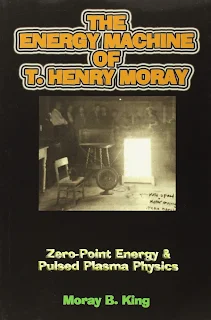king-the-energy-machine-of-t-henry-moray-zero-point-energy-and-pulsed-plasma-physics-
full text on blue link bellow
INSPIRATION FOR INVENTORS! FREE ENERGY THAT WORKS!
In the 1920s T. Henry Moray invented a "free energy" device that
reportedly output 50 kilowatts of electricity. It could not be explained
by standard science at that time. The electricity exhibited a strange
"cold current" characteristic where thin wires could conduct
appreciable power without heating. Moray suffered ruthless
suppression, and in 1939 the device was destroyed.
Frontier science lecturer and author Moray B. King explains the
invention with today's science:
Modern physics recognizes the vacuum contains
tremendous energy called the zero-point energy.
A way to coherently activate it appears surprisingly simple:
• First create a glow plasma or corona.
• Then abruptly pulse it.
Other inventors have discovered this approach (sometimes
unwittingly) and created novel energy devices, but they too were
suppressed. The common pattern of their technologies clarified the
fundamental operating principle. The purpose of this book is to
inspire engineers and inventors so that a new energy source can
become available to mankind.
Moray B. King, electrical engineer and systems engineer, is an
internationally recognized expert on the topic of zero-point energy,
and is well known in Tesla Technology and Frontier Physics circles.
He has been researching the field for 30 years, and has authored the
books Tapping the Zero-Point Energy and Quest for Zero-Point
Energy.
Dedication
In rememberance of Edwin Gray, Stephen Marinov, Stan Meyers,
Paul Brown, Eugene Mallove.
They gave their lives for their efforts to bring a new energy source
to mankind.
Table of Contents
The Energy Machine of T Henry Moray 11
Suppression 157
Patent of T Henry Moray 165
Bibliography 1
12
T. Henry Moray
The "free energy" invention of T. Henry Moray is probably the
most famous and well witnessed in the history of the field. The best
version of the device was claimed to yield 50 kilowatts of
electricity without using any known input power. Radioactive
material was used to maintain plasma activity in the tubes, but was
too weak to account for the output energy. The electricity exhibited
a strange "cold current" characteristic where appreciable power
could be guided on thin wires without heating them. Moray
suffered through ruthless suppression, and the device was
destroyed. T.H. Moray died in 1974, but his son, John Moray, was
funded to continue the research. The story continues today with
experimental results from other investigators such as Paul Brown,
Paulo and Alexandra Correa, Ken Shoulders and Edwin Gray,
contributing significantly to its understanding.


